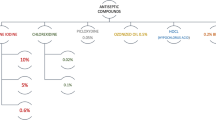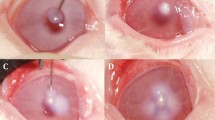Abstract
The poor intraocular penetration of systemically administered antibiotics has raised questions regarding their usefulness as prophylactic agents in the management of penetrating eye injuries. Cefazolin was administered intravenously to rabbits with penetrating eye injuries to determine the influence of trauma on ocular pharmacokinetics. Following a standardized penetrating eye injury in 27 New Zealand white rabbits, animals were divided into three groups that received either three, six, or nine doses of intravenous cefazolin every 8 h. Cefazolin levels were then measured in the traumatized eye, the non-traumatized (control) fellow eye, and in the serum of each animal. In the three treatment groups vitreous concentrations of cefazolin were significantly higher in traumatized eyes than in the non-injured eyes. After three doses, vitreous concentrations of cefazolin in traumatized eyes averaged 9.1 mg/l; mean concentrations of cefazolin in non-injured eyes were 0.6 mg/l (P < 0.0002). After six doses of intravenous cefazolin, vitreous concentrations in traumatized eyes averaged 7.3 mg/l; cefazolin levels in non-injured eyes were 0.6 mg/l in the non-traumatized eyes (P < 0.0005). After nine doses, vitreous cefazolin concentrations in traumatized eyes averaged 9.7 mg/l, while mean levels in the non-traumatized eyes were all 0.05 mg/l (P < 0.0002).
This work suggests that penetrating injuries of the eye alter ocular pharmacokinetics, resulting in high intraocular concentrations of systemically administered cefazolin.
Similar content being viewed by others
References
Abel R Jr, Boyle GL, Furman M, Leopoldl (1974) Intraocular penetration of cefazolin sodium in rabbits. Am J Ophthalmol 78:779–787
Affeldt JC Flynn HW Jr, Forster RK, Mandelbaum S, Clarkson JG, Jarus GD (1987) Microbial endophthalmitis resulting from ocular trauma. Ophthalmology 94:407–413
Alfaro DV, Pince K, Park J, Runyan T, Ryan SJ, Liggett PE (1992) Systemic antibiotic prophylaxis in penetrating ocular injuries; an experimental study. Retina 12:S3-S6
Axelrod JL, Klein RM, Bergen RL, Sheikh MZ (1985) Human vitreous levels of selected antistaphylococcal antibiotics. Am J Ophthalmol 100:570–575
Barza M, Kane E, Baum J (1983) Pharmacokinetics of intravitreal carbenicillin, cefazolin and gentamicin in rhesus monkeys. Invest Ophthalmol Vis Sci 24:1602–1607
Brinton GS, Topping TM, Hyndiuk RA, Aaberg TM, Reeser FH, Abrams GW (1984) Posttraumatic endophthalmitis. Arch Ophthalmol 102:547–550
Clearly PE, Ryan SJ (1979) Method of production and natural history of experimental posterior penetrating eye injury in the rhesus monkey. Am J Ophthalmol 88:212–220
Ficker LA, Meredith TA, Gardner SK, Wilson LA (1990) Cefazolin levels after intravitreal injection. Effects of inflammation and surgery. Invest Ophthalmol Vis Sci 31:501–505
Gardner SK (1987) Ocular drug penetration and pharmacokinetic principles. In: Lamberts DW, Potter DE (ed) Clinical ophthalmic pharmacology. Little, Brown, Boston, pp 1–52
Glasser DB, Hyndiuk RA (1987) Ocular penetration of antibiotics. In: Lamberts D.W., Potter D.E. (eds) Clinical ophthalmic pharmacology. Little, Brown, Boston, pp 525–566
Gregor Z, Ryan SJ (1982) Blood-retinal barrier after blunt trauma to the eye. Graefe's Arch Clin Exp Ophthalmol 219:205–208
Kervick GN, Flynn HW, Alfonso E, Miller D (1990) Antibiotic therapy for Bacillus species infections. Am J Ophthalmol 110:683–687
Latanza L, Alfaro DV, Bockman B, Iwamoto T, Heinemann MH, Chang S (1988) Leukotrienes levels in the aqueous humor following experimental ocular trauma. Retina 8:199–204
Leeds NH, Peyman GA, House B (1987) Moxalactam (Moxam) in the treatment of experimental staphylococcal endophthalmitis. Ophthalmic Surg 13:653–656
Martin DF, Ficker LA, Aguilar HA, Gardner SK, Wilson LA, Meredith TA (1990) Vitreous cefazolin levels after intravenous injection: effects of inflammation, repeated antibiotic doses, and surgery. Arch Ophthalmol 108:411–414
Parrish CM, O'Day DM (1987) Traumatic endophthalmitis. Int Ophthalmol Clin 27:112–119
Peyman GA, Carroll PC, Raichand M (1980) Prevention and management of traumatic endophthalmitis. Ophthalmology 87:320–324
Quintiliani R, French M, Nightingale CH (1982) First and second generation cephalosporins. Med Clin North Am 66:183–197
Spalding SC, Sternberg P (1990) Controversies in the management of posterior segment ocular trauma. Retina 10:S76-S82
Author information
Authors and Affiliations
Rights and permissions
About this article
Cite this article
Alfaro, D.V., Liggett, P.E. Intravenous cefazolin in penetrating eye injuries. Graefe's Arch Clin Exp Ophthalmol 232, 238–241 (1994). https://doi.org/10.1007/BF00184012
Received:
Revised:
Accepted:
Issue Date:
DOI: https://doi.org/10.1007/BF00184012




